Ask technical questions, discuss hifi, show pics of your gear: Join us on


Shopping Cart |

Accepted..
Cookie information:
We only use a session cookie. This cookie stores your shopping basket while your are navigating on our pages. The moment you leave NewClassD.com, the session cookie is destroyed, and erased. | | |
NCD1 and NCD4
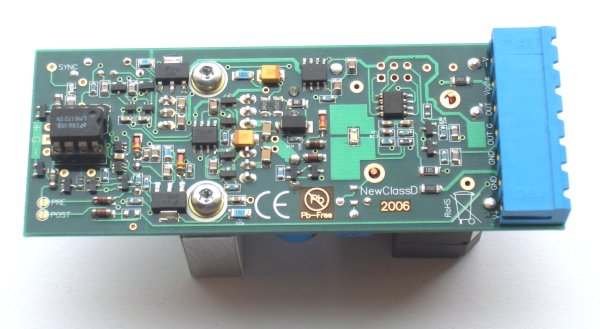
Click to Enlarge
NCD1 and NCD4 are now obsolete, and can no longer be ordered. We recommend NCDX and NCDXi-627.
The NewClassD Amplifier module is specially designed for the DIY market.
[NewClassD Cookbook 1.06 now available!]
[Review on Audiodesignguide.com]
[Difference between NCD1 and NCD4]
Each module is built on a Gold Plated 4 layer PCB board with uninterrupted high current power planes, for fantastic bass dynamics.
THD levels are the lowest in the Audio Industry at most load conditions, and at the most common conditions such as 1W @ 8 Ohm and 10W @ 4 Ohm, the distortion of the NewClassD module is 3 to 15 times lower than the leading other brands of Class D modules. This is a difference you can hear instantly.
Furthermore you get 115 dB of usable dynamic range, very low background noise, and wide bandwidth up to 120 kHz.
Unique Features Include:
 Dual Slope Nano Alignment for Ultra Low Distortion (<0.002%). Dual Slope Nano Alignment for Ultra Low Distortion (<0.002%).
 User choice of local or global feedback loop. User choice of local or global feedback loop.
 Risc Controller keeps each amplifier under full Software Control. Risc Controller keeps each amplifier under full Software Control.
 Effective Safety System, based on 'Seismic' Sensors, without current limiting resistors. Effective Safety System, based on 'Seismic' Sensors, without current limiting resistors.
 New Advanced Ferrite Core with very low THD and hysterisis loss. New Advanced Ferrite Core with very low THD and hysterisis loss.
 Power Supply with 12 Fast Recovery Diodes and 4 layer PCB. Power Supply with 12 Fast Recovery Diodes and 4 layer PCB.
[Read More...]
|
If you register [click], you can review this product
Take a look on the....
..Performance Graphs:
(Made with software from www.ymec.com)
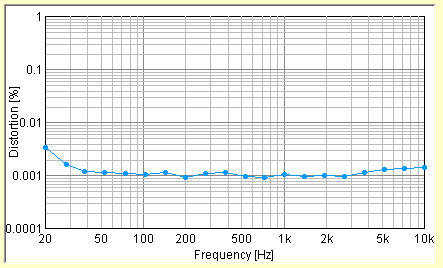 | THD level vs frequency at 1 Watt in 8 Ohms Load |
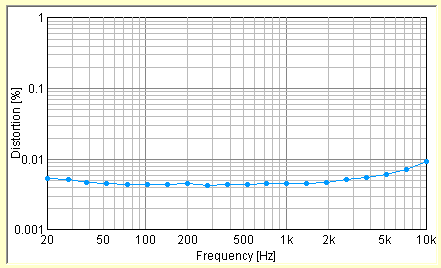 | THD level vs frequency at 40 Watts in 8 Ohms Load |
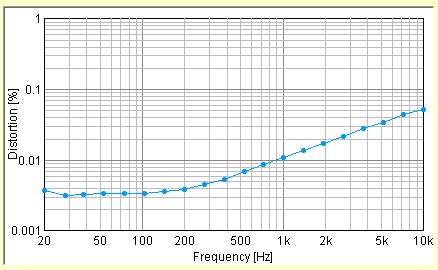 | THD level vs frequency at 100 Watts in 8 Ohms Load |
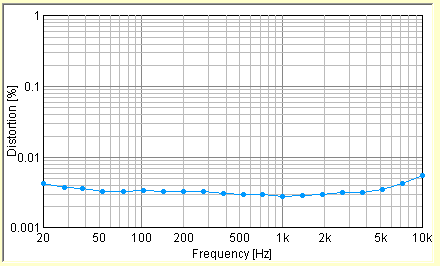 | THD level vs frequency at 10 Watts in 4 Ohms Load |
The low distortion and superb signal to noise ratio is not accomplished with high amounts of feedback. Heavy use of feedback will destroy the open and a-live sound properties.
Instead the good performance and incredible sound quality is accomplished by removing the sources of distortion within the signal chain. See more details below.
NewClassD modules are intended for building the best sounding amplifiers possible, and so costing a little more than the cheapest alternatives. However we don't think it's worthwhile to save a few buck's at the expense of getting second rate performance from your amplifier. When you look at the price of your completed amplifier, with enclosure, transformer, cables, connectors etc, we don't think it matters that the amplifier ended up costing 700 Euro, or 1000 Euro, if the difference means you get the best sounding amplifier on the planet.
Technical Details
NewClassD is based on a single loop self oscillating modulator, with dual slope dead-time compensation. A special technique called nano alignment effectively removes dead-time distortion, that is normally a major contributor of distortion in Class D amplifiers. Usually you can see dead-time distortion as a rise in THD levels at 5-7 kHz compared to 1 kHz. But not in NewClassD.
Advanced Ferrites
New advancements in Ferrite Materials, has moved the boundaries of what is possible to achieve in audio performance. This is one of the keys to obtaining NewClassD's ground breaking low distortion, without including the output filter in the feedback loop.
Direct Power Connection
In many Class D amplifiers the safety system is based on current measuring resistors. However these resistors have a side effect, as they increase the impedance of the power supply, and thus degrades bass dynamic performance. In NewClassD we have implemented a whole new type of current sensing technology, that enables the full potential of the power supply to be used. Instead of current measuring resistors, we use a special 'seismic sensor', that is able to sense current flow based on the voltage drop generated internally in power components. This means external resistors are no longer required, and the power component can now be connected directly to a huge uninterrupted powerplane, with hundreds of Ampere's current capability.
The result of this immense current capability is very good bass dynamics.
Software Control
A NewClassD amplifier is under software control. A microprocessor constantly monitors the parameters of the amplifier, and controls the operation to ensure safety and reliability if overload conditions should occur.
At testing point, software is downloaded into the memory of the microprocessor, which then monitors the Seismic Current Sensors, min and max voltage, DC offsets, powersupply pumping effects, oscillations etc. This also means that we can monitor the amplifier's vital parameters on a PC monitoring system, while testing the amplifier.
The relatively intelligent safety system means we can prevent your amplifier from getting into trouble under most circumstances, but it does not mean that it will shut down every 15 minutes during your new years party. A NewClassD module is rugged, and can play 24 hours a day with full power and more for weeks. |
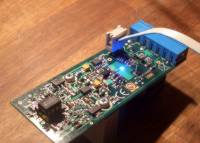
Click to Enlarge |
Facts about the Microprocessor Control
 The Microprocessor is an Atmel AVR ATtiny13-20 The Microprocessor is an Atmel AVR ATtiny13-20
 It runs on 9,6 MHz Clock, and executes around 9 MIPS (Million Instructions per Second). This is speed comparable to an i386 25 MHz PC, you might recall from an ancient past. It runs on 9,6 MHz Clock, and executes around 9 MIPS (Million Instructions per Second). This is speed comparable to an i386 25 MHz PC, you might recall from an ancient past.
 It has 10 bit A/D converters for measuring voltages. It has 10 bit A/D converters for measuring voltages.
 When the amplifier clicks on after a 2 second delay, a snapshot of all power supply Voltages is stored in memory, to compare with actual operation conditions. Should the voltage at any time surge more than 10% the PSU-Pumping event will be issued, and the amplifier will shut down for a few seconds, for safety. When the amplifier clicks on after a 2 second delay, a snapshot of all power supply Voltages is stored in memory, to compare with actual operation conditions. Should the voltage at any time surge more than 10% the PSU-Pumping event will be issued, and the amplifier will shut down for a few seconds, for safety.
 A Black Box function is implemented in the chip. If a module is shipped back for service, we can use the internal datafile, to follow the events from the last 2 hours of operation. A Black Box function is implemented in the chip. If a module is shipped back for service, we can use the internal datafile, to follow the events from the last 2 hours of operation.
 It is programmed in C language. It is programmed in C language.
 It is reprogrammable, with a programming dongle, connecting the amplifier to a PC, and using input from a hex file published here on NewClassD.Com if future updates should become necessary. It is reprogrammable, with a programming dongle, connecting the amplifier to a PC, and using input from a hex file published here on NewClassD.Com if future updates should become necessary.
|
The switching frequency is adjustable in the range of 330 to 1000 kHz. (However as changing the switching frequency will affect the performance and reliability of your amplifier, we recommend not adjusting it).
Local or Global Feedback?
Both! The feedback loop is normally taken before the output filter, as this gives the best sound quality. Theoretically it is best to include the output filter in the feedback loop, so letting the amplifier compensate for the changing load effect on frequency linearity. This works, but unfortunately has some serious side effects. One is that the complex load of the loudspeaker will constantly interact with the loopgain of the amplifier, and so change it's sound. In real life audible terms you will get a rubber like and dull bass reproduction. It's characteristic of all global feedback amplifiers.
However it's a controversial topic, and there are in fact some cases where post filter feedback is an advantage. Therefore we've implemented user selectable pre and post filter by selecting the appropriate solder pads.
(As shown below).
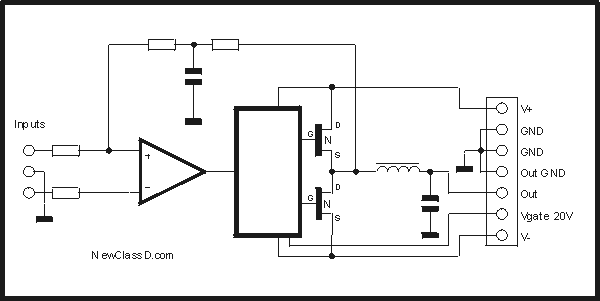
Basic internal configuration in the recommended mode with local feedback. (PRE filter mode).
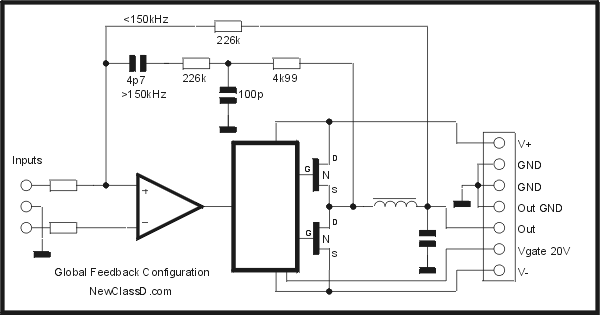
But easily set up in global feedback mode, by selecting a bubble. (POST filter mode).
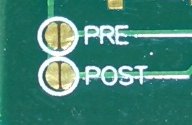 | Feedback mode selector bubbles. Observe the Gold Plated surface of the PCB. |
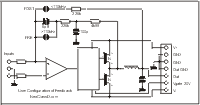
Click to Enlarge |
Here is the schematic setup for these setting bubbles. When the PRE bubble is shorted, feedback is taken before the choke, through the 226k feedback resistor. This gives a short local feedback loop, with very low delay. The 6p8 capacitor is shorted, and so has no effect.
When the POST bubble is shorted, feedback is taken after the output choke, ad so forming a global feedback loop. A switching control loop is established through the 6p8 capacitor. Thus forming a stable switching network, independent of capacitive load on the output, and also without limiting the audio bandwidth, as seen with other solutions.
|
Technical Data
(VDD and VSS = 63V unless otherwise specified).
| Output Power 8 Ohms | 200 Watts RMS |
| Output Power 4 Ohms | 400 Watts RMS |
| Input | Balanced and Unbalanced |
| Input Impedance | 5k |
| Input Level | 0.9V RMS (200W 8Ohms) |
| Gain | 45 |
| THD @ 1W 8Ohm 1 kHz | 0.001% typ |
| THD @ 1W 8Ohm 1 kHz | 0.002% max |
| Frequency Response @ 8 Ohms | 2 - 120.000 Hz +-3dB |
| RMS current | 11 Ampere |
| Peak current 1mS | 40 Ampere |
| Switching Frequency | 330 - 1040 kHz adj |
| Supply Voltage Range | 25 - 65 Volts DC |
| Gate Drive Voltage Range | 17 - 25 Volts DC |
| Module Size | 38 x 100 x 30 mm |
|
The module is fixed on a solid aluminium block, providing cooling for the powerful MOSFETS and also mechanical stability. With M3 threads on the bottom side, the module is easy to mount on the base or bottom of the enclosure. The Aluminium block is isolated, and has only a 100 nF capacitor coupling it to GND. The blue trimmers adjust Dead Time and switching frequency. The trimmers are factory set, for optimal THD and sound performance. We recommend NOT retrimming the module, as this may damage the module. (If adjusted to shoot through mode). |
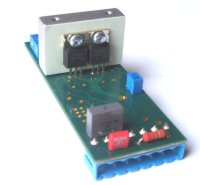
Click to Enlarge |
|
The Advanced High Frequency Ferrite choke is placed on the underside, where 2 solid layers of copper provide the sensitive audio circuitry of the top side with shielding from the coil's near field disturbance. Note this choke is only for testing, and is not the type supplied with the actual modules. |
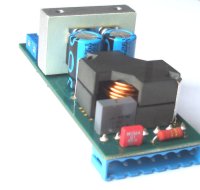
Click to Enlarge |
What you need to build a complete amplifier.
This list covers a complete stereo power block amplifier of 2 x 200W in 8 Ohms.
| 2 | NCD 4 modules |
| 1 | NewClassD PSU module |
| 1 | Toroid transforfmer 2 x 40-42 V AC 400 - 500 VA. |
| 1 | NewClassD Enclosure complete with brackets and IEC inlet [click] |
| 4 | WBT710 binding post |
| 2 | WBT210 RCA connector |
| 2 | Neutrik NC3-FD-H-B |
| 1 | IEC standard mains lead |
All our microcontroller software is made with Codevision AVR.
|
|
|